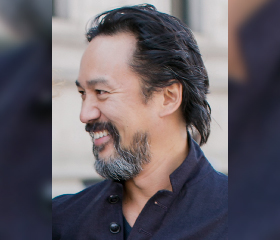Before I spoke with Lap Chi Chu, the lighting designer for both The Coast Starlight and Camelot, I would have said that the primary function of lighting is to create a mood. The other day, Lap, who is a professor and head of lighting design at UCLA’s theater department, assumed a gentle classroom mode and set me right. “Lighting doesn’t create a mood. It creates a context.”
He offered an example. “We say that a candlelight dinner creates a romantic mood. But what if two people having that dinner are breaking up? The dinner becomes something else. Then the lighting is taking place in a different context.”
Lap moved on to an example from Keith Bunin’s The Coast Starlight. “The play takes place on a train,” he said. “There’s a moment when the characters walk into the observation car. Instead of illustrating windows and seats arranged in a certain way, we made the scene bright and open to express a feeling of surprise and lack of constraint. We lit the meaning of the scene rather than the mood.”
Lap of course takes many of his ideas for lighting from the playwright’s words. But theater texts also have a personal meaning for him. “I was born in the U.S., but I spent my early childhood in Hong Kong. My first language is Chinese (Cantonese), and when I came back to the U.S. at the age of six and had to learn how to read in English, I had trouble. I was confused by description and narration. When I got to college and graduate school” – Northwestern, NYU – “I found that if I focused hard on the text that I learned a lot about English. This has been especially true with new plays.”
Lap, who has an Obie Award for Sustained Excellence in Lighting Design, was associated with a new play previously at LCT, in the Newhouse: The Wolves. The Coast Starlight is also a new work. And even the text for LCT’s Vivian Beaumont production of Camelot, by Aaron Sorkin, is credited as “a new book.” “One of the many pleasures of working on new plays,” Lap said, “is that I have the possibility of communicating with the writers, which is very helpful.”
Theater is an intensely collaborative art form, and with The Coast Starlight and Camelot Lap has found it more collaborative than ever. On both shows he has been working with Ben Pearcy, of 59 Productions, who does the projections. Lap said: “It’s hard to say sometimes where the lighting design ends and the projections begin.” For example, Lap revealed that he sometimes uses video-type tools: “One of them is pixel mapping, which is a way to use video content to control the lights.” He added: I’m fortunate to work with Ben, because we are both trying to use whatever tools we have to tell the story the best way possible.”
Lap’s first collaboration with Bartlett Sher, the director of Camelot, came in the late 1990s, at Portland Stage Company, in Portland, Maine. Lap remembered: “It was on Nora, Ingmar Bergman’s adaptation of A Doll’s House. Years later, I re-connected with Bart when I was here working on The Wolves.” Sher at that moment was working on LCT’s acclaimed production of My Fair Lady.
Lap’s resume is not heavy on musicals. “That’s not by design,” he explained. “Your career tends to be shaped by other artists who you find you can work with in a fulfilling and trusting way. For me, those artists have generally been involved with plays.” Lap added that while he's happy to be back at the Newhouse working on a play, he relishes the chance to make his debut with a musical in the Beaumont. Why? “There’s no other theater quite like it.”
Brendan Lemon is a freelance journalist in New York.
